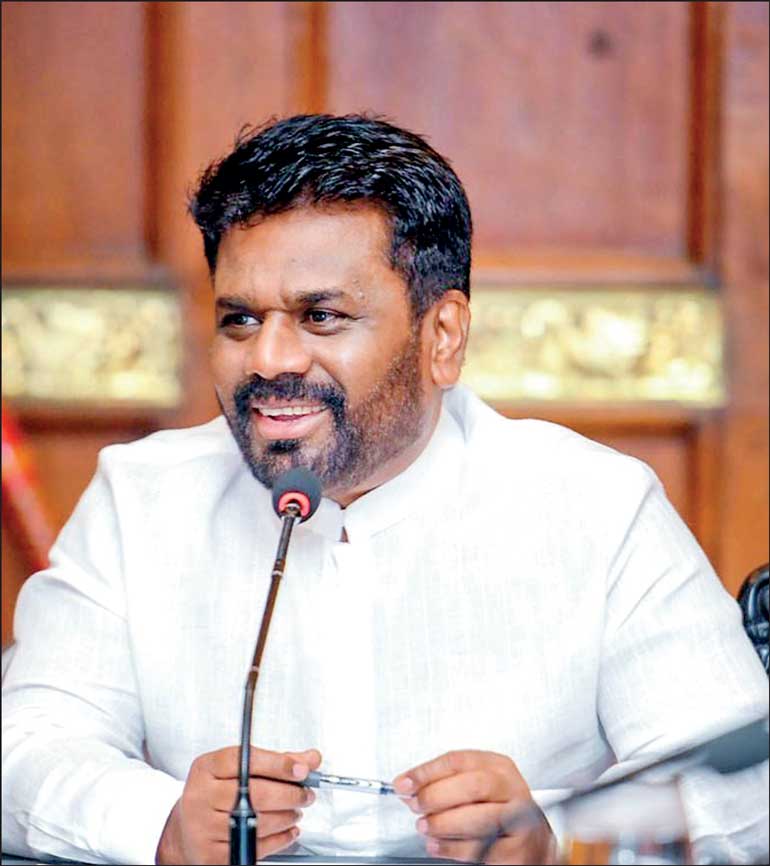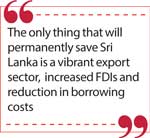Wednesday Nov 05, 2025
Wednesday Nov 05, 2025
Wednesday, 5 November 2025 00:20 - - {{hitsCtrl.values.hits}}

President Anura Kumara Disanayake
 Achieving IMF program targets and ensuring macroeconomic stability (objective 1) is excellent news. But does this mean that Sri Lanka is on its way to long term steady economic growth and that Sri Lanka’s debt (especially external debt) is sustainable (objective 2)? Many Sri Lankans confuse these 2 objectives. Not just Sri Lankans but many other countries too confuse these. A good example was Argentina in the late 1990s when Argentina was praised by the IMF for achieving its targets, Argentina’s government believed in the praises of the IMF, became overconfident and Argentina defaulted again in late 2001.
Achieving IMF program targets and ensuring macroeconomic stability (objective 1) is excellent news. But does this mean that Sri Lanka is on its way to long term steady economic growth and that Sri Lanka’s debt (especially external debt) is sustainable (objective 2)? Many Sri Lankans confuse these 2 objectives. Not just Sri Lankans but many other countries too confuse these. A good example was Argentina in the late 1990s when Argentina was praised by the IMF for achieving its targets, Argentina’s government believed in the praises of the IMF, became overconfident and Argentina defaulted again in late 2001.
Government performance on economic stability
Before I get to the point, let me state that I am in no way downplaying the economic policies related to macroeconomic stability and meeting IMF targets by the present government or the previous government of Ranil Wickremesinghe. The government is doing a good job as far as macroeconomic stability is concerned. Sri Lanka’s Inflation rate, primary surplus, current account, interest rates and growth are very good for a country that declared bankruptcy on its external debt just 3 years ago. Credit should be given where due.
IMF
I would say that both the IMF and the Central Bank have overperformed in Sri Lanka with their mandates. Many local critics criticise the IMF for not bringing higher growth and reducing the burden on the poor. What is not understood by the Sri Lankan public at large is that the IMF is not a development bank. The IMF’s role and mandate is to stabilise countries which are defaulting or close to defaulting and have macroeconomic instability. The Central Bank’s core mandate is to ensure price stability and its secondary objective is for financial sector stability. Ensuring long term economic growth and transforming Sri Lanka into a developed nation is not the mandate of the IMF or Central Bank. That is the responsibility of the Finance Ministry. Let me give a simple layman example.
 The IMF is like a Doctor at the Intensive care unit (ICU). The patient (Sri Lanka) is admitted when he is in a very unstable health condition where survival itself is a question. The ICU doctor’s (IMF) role is to bring the patient back to stability where the health indicators (like macroeconomic indicators) such as blood pressure, cholesterol and sugar levels are brought back to normal. Now this patient is expected to run a 100 metre race (economic growth). When the patient (Sri Lanka) was asked the question, “How are you going to run the 100 metre race?”, the patient replied, “My ICU doctor (IMF) said my blood pressure, cholesterol and sugar levels are excellent, therefore I can win this 100 metre race”. Of course, having your blood pressure, cholesterol and sugar levels at good levels is essential for running a 100 metre race. No one can run a 100 metre race when they have high pressure and high sugar levels, they will collapse. But at the same time, having your blood pressure and sugar levels as normal does not mean that you will win the race.
The IMF is like a Doctor at the Intensive care unit (ICU). The patient (Sri Lanka) is admitted when he is in a very unstable health condition where survival itself is a question. The ICU doctor’s (IMF) role is to bring the patient back to stability where the health indicators (like macroeconomic indicators) such as blood pressure, cholesterol and sugar levels are brought back to normal. Now this patient is expected to run a 100 metre race (economic growth). When the patient (Sri Lanka) was asked the question, “How are you going to run the 100 metre race?”, the patient replied, “My ICU doctor (IMF) said my blood pressure, cholesterol and sugar levels are excellent, therefore I can win this 100 metre race”. Of course, having your blood pressure, cholesterol and sugar levels at good levels is essential for running a 100 metre race. No one can run a 100 metre race when they have high pressure and high sugar levels, they will collapse. But at the same time, having your blood pressure and sugar levels as normal does not mean that you will win the race.
Macroeconomic stability is absolutely essential for steady economic growth and long term debt sustainability. But having macroeconomic stability does not guarantee long term economic growth. Macroeconomic stability looks good for Sri Lanka right now because we just came out of the worst parts of the 2022 economic crisis.
Having macroeconomic stability and achieving IMF targets is needed, but it is not an achievement that will take Sri Lanka forward to long term economic growth and bringing long term debt sustainability. Sri Lanka had macroeconomic stability during former President Chandrika Bandaranaike’s time (1994-2005) except briefly for 2001. Sri Lanka had macroeconomic stability during former President Mahinda Rajapakse’s time (2005-2015). Sri Lanka had macroeconomic stability during Yahapalanaya time to a large extent (2015-2019). Sri Lanka is basically back to 2018 but the only difference is that our debt is much higher and our credit ratings are much lower. Below are two differing examples of Argentina and Mexico. Of course, both nations had many other economic issues which I am unable to write here..
Example of Argentina before 2001 default
Argentina was doing well in the 1990s. It was performing well according to the IMF. The IMF actually kept praising Argentina for its performance. Similar to how Sri Lanka is also being praised now by the IMF and rightly so. I have been reading on the Argentine economic crisis up to its default in late 2001, and one of the books, “And the money kept rolling In (and Out) Wall Street, the IMF and the bankrupting of Argentina”, gives a detailed account of what went on before the default. The fixed convertibility of the Argentine currency to the US Dollar also played a major part. One of the issues was that as the IMF started giving positive feedback, the Argentine governments also felt comfortable and became complacent. The fiscal deficits were high with the government not reducing public spending. Confidence in the Argentine economy faded fast. Argentina could not borrow externally as the country’s risk premium was 15% higher than a US treasury bond which was unacceptable to foreign investors. Argentina defaulted in late 2001. It was quite ugly with a lot of suffering for the people of Argentina.
Example of Mexico in 1994-1995
Mexico’s example is something Sri Lanka should pay close attention to. Sri Lanka is being praised and rightly so, for overachieving its primary budget targets (IMF set it for 2.3% of GDP). Sri Lanka has reduced its fiscal deficit size also, though it has to be noted that Sri Lanka is still running a fiscal deficit. Mexico performed much better from 1983 to 1994 when compared to Sri Lanka’s current performance. For 11 years it ran primary surpluses. Mexico even ran a fiscal surplus in the 3 years just before its crisis in 1994-1995. In 1991, 1992 and 1993, Mexico ran a fiscal surplus which included a fiscal surplus of over 3% in 1992. Achieving a fiscal surplus is a much larger achievement than achieving a primary budget surplus. These were much more impressive than Sri Lanka’s current performance. Yet, in 1994, it was on the verge of defaulting. Why did this happen if Mexico was performing so well on its macroeconomic indicators? In the second quarter of 1994, US interest rates began to rise, there was political instability due to the assasination of a presidential candidate in Mexico and the Mexican Central Bank tried to maintain its exchange rate, resulting in depleting its reserves. Foreign markets refused to grant new loans and finally Mexico was on the verge of default. The United States government and the IMF saved Mexico with a huge emergency loan.
Lessons from Argentina and Mexico
 The lesson from Argentina is that even if the IMF says all is well and the IMF is right, the Sri Lankan government should not become overconfident. The IMF’s mandate is to bring macroeconomic stability, which is to help a country which is at or close to the stage of economic collapse, back on its feet so it can once again borrow from elsewhere. So, when the IMF says things are good, the IMF is saying this from its mandate’s perspective. The lesson from Mexico is that even if Sri Lanka performs exceptionally well on all macroeconomic fronts, it can still be vulnerable. The US interest rates going up in 1994 which was beyond Mexico’s control was the trigger that set off the road to Mexico’s near default during 1994-1995.
The lesson from Argentina is that even if the IMF says all is well and the IMF is right, the Sri Lankan government should not become overconfident. The IMF’s mandate is to bring macroeconomic stability, which is to help a country which is at or close to the stage of economic collapse, back on its feet so it can once again borrow from elsewhere. So, when the IMF says things are good, the IMF is saying this from its mandate’s perspective. The lesson from Mexico is that even if Sri Lanka performs exceptionally well on all macroeconomic fronts, it can still be vulnerable. The US interest rates going up in 1994 which was beyond Mexico’s control was the trigger that set off the road to Mexico’s near default during 1994-1995.
Conclusion
Sri Lanka should always be cautious and the only thing that will permanently save Sri Lanka is a vibrant export sector, increased FDIs and reduction in borrowing costs. Sri Lanka has done remarkably well when compared to the deep crisis we were in in 2022 and I am not trying to dampen the mood. But the truth is that as stated by the IPS State of the Economy 2025 report, the economic growth currently seen by Sri Lanka is not yet been driven by structural reforms, technological infusion (like AI driving growth in the US) or infrastructural improvements which are the ones which will create a strong foundation for economic long term growth. Sri Lanka’s economic growth is also cyclical growth recovery which is caused by a recovery in consumer spending and investment. Sri Lanka should also note that the current global environment is also not friendly with the geopolitical rivalry between the US and China and a shift towards protectionism led by the world’s largest economy. I am not being optimistic or pessimistic, but just being realistic.
(The author is an Economist. He was a Director at Ernst & Young and he was a consultant to the ADB. He is a regular contributor to the IMF’s public finance forum and he is currently pursuing his PhD specializing on public debt.)